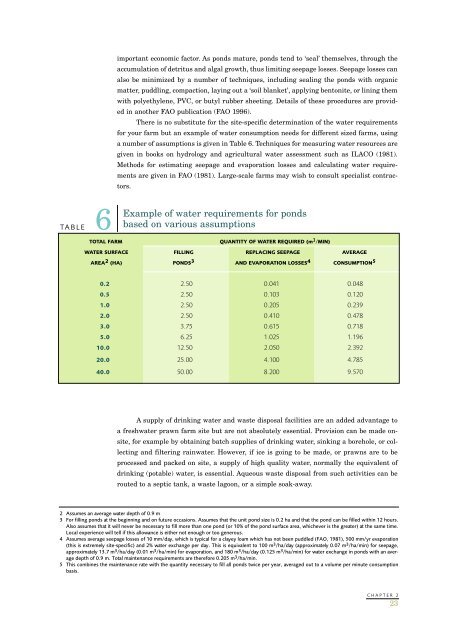Create successful ePaper yourself
Turn your PDF publications into a flip-book with our unique Google optimized e-Paper software.
important economic factor. As ponds mature, ponds tend to ‘seal’ themselves, through theaccumulation of detritus and algal growth, thus limiting seepage losses. Seepage losses canalso be minimized by a number of techniques, including sealing the ponds with organicmatter, puddling, compaction, laying out a ‘soil blanket’, applying bentonite, or lining themwith polyethylene, PVC, or butyl rubber sheeting. Details of these procedures are providedin another FAO publication (FAO 1996).There is no substitute for the site-specific determination of the water requirementsfor your farm but an example of water consumption needs for different sized farms, usinga number of assumptions is given in Table 6. Techniques for measuring water resources aregiven in books on hydrology and agricultural water assessment such as ILACO (1981).Methods for estimating seepage and evaporation losses and calculating water requirementsare given in FAO (1981). Large-scale farms may wish to consult specialist contractors.TABLE 6Example of water requirements for pondsbased on various assumptionsTOTAL FARMQUANTITY OF WATER REQUIRED (m 3 /MIN)WATER SURFACE FILLING REPLACING SEEPAGE AVERAGEAREA 2 (HA) PONDS 3 AND EVAPORATION LOSSES 4 CONSUMPTION 50.2 2.50 0.041 0.0480.5 2.50 0.103 0.1201.0 2.50 0.205 0.2392.0 2.50 0.410 0.4783.0 3.75 0.615 0.7185.0 6.25 1.025 1.19610.0 12.50 2.050 2.39220.0 25.00 4.100 4.78540.0 50.00 8.200 9.570A supply of drinking water and waste disposal facilities are an added advantage toa <strong>freshwater</strong> prawn farm site but are not absolutely essential. Provision can be made onsite,for example by obtaining batch supplies of drinking water, sinking a borehole, or collectingand filtering rainwater. However, if ice is going to be made, or <strong>prawns</strong> are to beprocessed and packed on site, a supply of high quality water, normally the equivalent ofdrinking (potable) water, is essential. Aqueous waste disposal from such activities can berouted to a septic tank, a waste lagoon, or a simple soak-away.2 Assumes an average water depth of 0.9 m3 For filling ponds at the beginning and on future occasions. Assumes that the unit pond size is 0.2 ha and that the pond can be filled within 12 hours.Also assumes that it will never be necessary to fill more than one pond (or 10% of the pond surface area, whichever is the greater) at the same time.Local experience will tell if this allowance is either not enough or too generous.4 Assumes average seepage losses of 10 mm/day, which is typical for a clayey loam which has not been puddled (FAO, 1981), 500 mm/yr evaporation(this is extremely site-specific) and 2% water exchange per day. This is equivalent to 100 m 3 /ha/day (approximately 0.07 m 3 /ha/min) for seepage,approximately 13.7 m 3 /ha/day (0.01 m 3 /ha/min) for evaporation, and 180 m 3 /ha/day (0.125 m 3 /ha/min) for water exchange in ponds with an averagedepth of 0.9 m. Total maintenance requirements are therefore 0.205 m 3 /ha/min.5 This combines the maintenance rate with the quantity necessary to fill all ponds twice per year, averaged out to a volume per minute consumptionbasis.CHAPTER 223
















